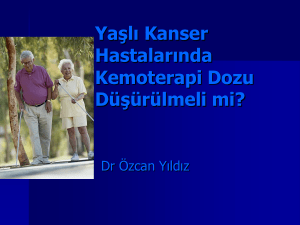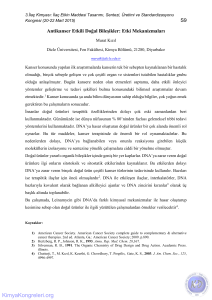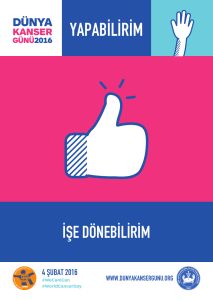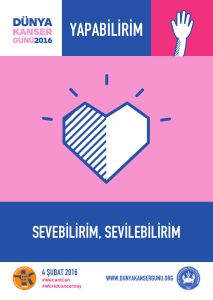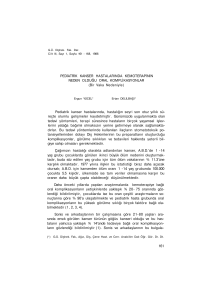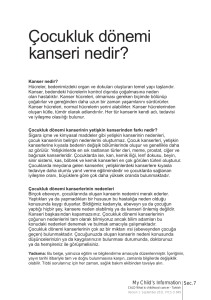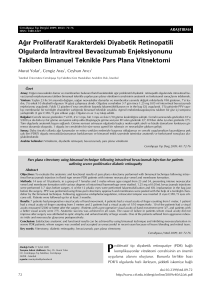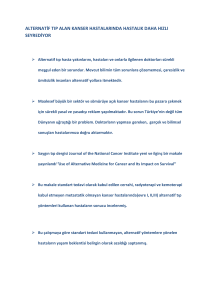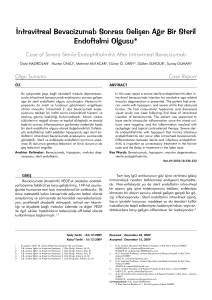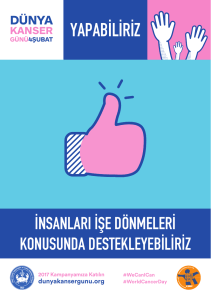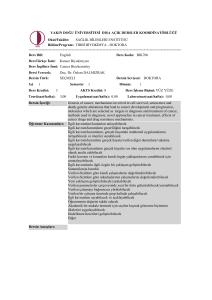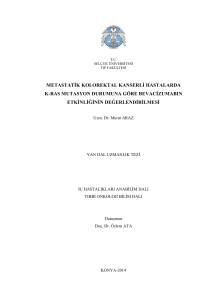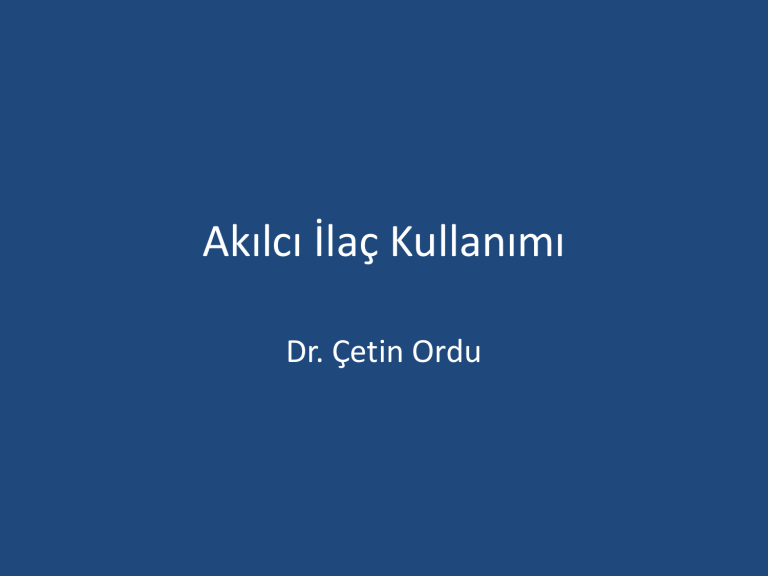
Akılcı İlaç Kullanımı
Dr. Çetin Ordu
• Akılcı İlaç Kullanımı (AİK); hastaların ilaçları
klinik ihtiyaçlarına uygun şekilde, kişisel
gereksinimlerini karşılayacak dozlarda, yeterli
zaman diliminde, kendilerine ve topluma en
düşük maliyette almalarını gerektiren kurallar
bütünüdür.
• Bu kurallara uyulmaması ise Akılcı Olmayan
İlaç Kullanımı (AOİK) olarak anılmaktadır
Bu konuda yapılmış olan araştırmalarda tespit
edilen temel problemler arasında
• gereğinden fazla ilaç yazdırılması (polifarmasi),
• ilaçların yanlış şekilde kullanılması, temel ilaç
listelerine veya güncel kılavuzlara uygun olmayan
ilaçların reçetelere yazılması,
• özel hasta gruplarına uygunsuz ilaç yazılması,
• gereksiz yere pahalı ilaçların kullanımı,
• gereksiz yere antibiyotik tüketimi
• gereksiz yere enjeksiyon önerilmesi vb. sayılabilir
AİK
• Doktorun hastayı değerlendirdikten sonra
problemi belirlemesi
• Tedavideki amacın belirlenmesi
• Uygun ilaç tedavisinin seçilmesi
• Tedavinin ayrıntılarıyla uygulanması ve ilaç dışı
tedavilerin tasarlanması
• Gerekli bilgi ve uyarıların verilmesi
• Tedavi sonuçlarının düzenli olarak takibi ve
gerekirse ilaç tedavisinin kesilmesi
• Dünya genelinde reçete edilen hazırlanan veya
satılan ilaçların yarısından fazlasının uygun
olmadığı tahmin edilmektedir.
• Hastaların yarısının kendisine reçete edilen
ilaçları uygun kullanmadığı düşünülmektedir.
• ABD’de ilaç yan etkilerine bağlı ölümler ilk 10
sıra içinde yeralmaktadır.
İlaçların bilimsel temelde doğru ve
uygun kullanılması için öncelikli olarak
• hastalığın doğru teşhisi yapılmalıdır. Konulan
teşhise bağlı olarak diğer tedavi seçeneklerinin
değerlendirilmesi ve ilaç tedavisi uygun
görülürse de mümkün olduğunca daha etkili,
tedavi hedeflerine ulaşma hususunda daha
çabuk sonuç veren, yan etkisi en az olan ve
tedavi maliyeti daha ucuz olan ilacın tercihi
AİK’in genelprensipleri arasında sayılmaktadır
Kişilerin ilaçları;
klinik gereksinimlerine uygun biçimde
kişisel gereksinimi karşılayacak dozlarda
yeterli zaman diliminde
kendilerine/topluma en düşük maliyette
kolayca almaları için uyulması gereken
kurallar bütünü
AKILCI İLAÇ KULLANIMI
(WHO, 1985, Nairobi)
Conference of Experts on the Rational Use of Drugs, World Health Organization, Nairobi, Kenya, WHO/CONRAD/WP/RI, (25-29.12.1985).
7
•
•
Ülkemizde
%18.1 ile antibiyotikler
%12.3 ile ağrı kesiciler
%11 ile antiromatizmal ilaçlar
%8.4 ile soğuk algınlığı ve öksürük ilaçları
İşverenler Sendikası’nın 2010 verilerine göre,
Türkiye reçeteli ilaç pazarı tutar ölçeğinde
%1.2 oranında daralarak 13.9 milyar TL’ye (9.2
milyar USD), kutu ölçeğinde %2.8 oranında
büyüyerek 1.45 milyar kutuya ulaşmıştır.
• 2010 yılında kişi başına düşen ilaç tüketimi
Türkiye’de 133 Dolar olarak bulunmuştur.
ABD’de kişi başı ilaç harcaması 956 Dolardır.
Kişi başına ilaç tüketiminin gelişmiş ülkelerde
daha fazla olduğunu görmekteyiz
• Onkoloji ilaçları ise 2003’te %3.8 iken 2010’da
tüm ilaç harcamalarının %7.2’sini
oluşturmaktadır
• OECD ülkeleri başta olmak üzere gelişmiş
ülkelerde ilaç harcamalarının toplam sağlık
harcamaları içindeki payı %20’lere yaklaşırken,
gelişmekte olan ülkelerde ilaç harcamalarının
toplam sağlık harcamalarındaki payı %20-40
arasında değişmektedir.
• Avrupa ülkelerinde sağlık harcamalarının %1015’i ilaç harcamalarına ayrılırken, ülkemizde
bu oran % 40’ın üzerindedir
• Ülke ekonomisi zorlayacak kritik nokta %10
ÜLKE
TÜKETİLEN
İLAÇ TUTARI
MİLLİ GELİR
KİŞBAŞI MİLLİ
GELİR
KİŞİBAŞI
TÜKETİLEN
İLAÇ TUTARI
ABD
198 MİLYAR$
13.2 TRİLYON$
44 BİN$
661$
İNGİLTERE
15.7 MİLYAR$
2.3 TRİLYON$
39 BİN$
260$
TÜRKİYE
7 MİLYAR$
400 MİLYAR$
5500$
100$
2006 yılında ilaç tüketiminin ulusal gelire oranı 1.75
ABD’de bu oran
1.50
• Ankara Ticaret Odası (ATO) tarafından
hazırlanan “İlaçta İsraf” konulu rapora göre;
ülkemizde eczanelerdeki ilaçların ortalama
%7’si kullanım süresi dolduğu için çöpe
atılmakta, evlerde ise ilaçların %60’ının kutusu
dahi açılmadan tarihi sona ermektedir. Tüm bu
çöpe giden ilacın maliyeti ise yaklaşık 500
milyon doları bulmaktadır
• Ülkemizde Sosyal Güvenlik Kurumları’nın ilaç
harcamaları nominal olarak TL bazında
2010’da, 2005 yılına göre %76,7; reel olarak
%15,4 oranında artmıştır.
• 2009 verilerine göre kanser tedavisinde
800’den fazla ilaç araştırma halinde,
• Bunların ancak %5-8’ i kullanılabilir ilaç haline
gelebilecek.
• FDA’ e 1996-2009 yılları arasında yeni
moleküler ajanlar için başvuru sayısında artış
var.
Akılcı İlaç Kullanımında Dikkat Edilmesi
Gereken Durumlar
•
•
•
•
•
Hekim
Hasta
Eczacı
İlaç Endüstrisi
Sağlık Bakanlığı
AİK ilkeleri (WHO)
• İlaç politikalarını ve etkilerini takip edecek yapılar
• Kanıta dayalı tıp yada rehberlere uygun tedaviler
düzenlenmesi
• Geri ödeme listesindeki ilaçları kullanmak
• Hastanelerde ilaç ve tedavi komiteleri kullanılması
• Üniversitelere farmokoterapiye yönelik eğitim
programları kurmak
• Hizmet içi eğitim verilmesi
AİK ilkeleri (WHO)(devam)
• Denetim ve feedback mekanizmalarını
geliştirmek
• İlaçlar ile ilgili bağımsız bilgilere ulaşılabilmesi
• İlaçlar ile ilgili halkın eğitilmesi
• AOİK ile ilgili yanlış ve özendirici reçetelemelerin
önlenmesi
• WHO’nun etik kriterlerine uygun ilaç
promosyonlarının sağlanması
• Devletin güvenli ve kaliteli ilaç ve sağlık
personelinin sağlanması için gerekli bütçe
rezervlerinin sağlanması
Maliyet-etkinlik
• 139 onkolog
• %78’i hastalarını tedavi ederken maliyet etkinliği
düşünmediğini ifade etmiş.
• Ortalama 2-4 aylık survival avantajının yıllık 70.000 $
maliyeti makul bulmuşlar
• Önümüzdeki 5 yılda maliyet etkinlik hesaplarının
önemli olacağını öngörmüşler
• Bevacizumabın yıllık maliyetinin gerçek maliyetinden
daha yüksek olduğunu ve survival katkısının
(metastatik kolorektal kanserde) daha düşük olduğunu
tahmin etmişler.
Nadler ve ark. Do Oncologists Believe New
Cancer Drugs Offer Good Value? The
Oncologist 2006;11:90–95
•
•
•
•
•
•
•
•
•
•
•
•
•
•
Subcategory:
Cost
Category:
Health Services Research
Meeting:
2014 ASCO Annual Meeting
Session Type and Session Title:
Oral Abstract Session, Health Services Research
Abstract Number:
6502
Citation:
J Clin Oncol 32:5s, 2014 (suppl; abstr 6502)
Author(s):
Daniel A. Goldstein, Qiushi Chen, David H. Howard, Joseph Lipscomb, Turgay Ayer, Bassel F. El-Rayes, Christopher Flowers; Winship Cancer Institute
of Emory University, Atlanta, GA; H. Milton Stewart School of Industrial & Systems Engineering, Georgia Institute of Technology, Atlanta, GA; Emory
University Department of Health Policy and Management, Atlanta, GA; Rollins School of Public Health; Winship Cancer Institute, Atlanta, GA; H.
Milton Stewart School of Industrial and Systems Engineering, Georgia Institute of Technology, Atlanta, GA; The Winship Cancer Institute of Emory
University, Atlanta, GA; Hematology and Medical Oncology, Winship Cancer Institute of Emory University, Atlanta, GA
•
•
•
•
Abstracts that were granted an exception in accordance with ASCO's Conflict of Interest Policy are designated with a caret symbol (^).
Abstract Disclosures
Abstract:
Background: The addition of Bev to 5-Fluorouracil (5-FU)-based chemotherapy is the standard of care for previously untreated mCRC. A recent
randomized trial demonstrated a 1.4 month increase in median overall survival (OS) when Bev is continued beyond the first progression, thus making
it standard practice to use Bev with 5-FU based chemotherapy in both first- and second-line. International CEAs have evaluated Bev in the 1st-line
setting. The objective of this study is to determine the cost effectiveness of Bev in the 1st line setting and when continued beyond progression from
the US-payer perspective. Methods: We developed two Markov models to compare the cost and effectiveness of 5-FU, leucovorin and oxaliplatin
(FOLFOX) with or without Bev in the first-line treatment, and subsequent chemotherapy with or without Bev in the second-line treatment of mCRC.
Weibull models were fitted to the published survival curves, and were used to extrapolate the cause-specific mortality and progression risks. Costs
for administration and management of adverse events were based on Medicare reimbursement rates for hospital and physician services, and drug
costs based on the Medicare average sale prices (all in 2013 US $). Health outcomes were measured in life years (LY) and quality-adjusted life years
(QALYS). The simulated OS and progression free survival (PFS) were validated by the fitted survival models. Model robustness was addressed by
univariate and probabilistic sensitivity analyses (PSA).Results: Using Bev in first-line therapy provided an additional 0.289 QALYs (0.412 LYs) at a cost
of $69,381. The incremental cost-effectiveness ratio (ICER) was $240,195/QALY. Continuing Bev beyond progression provided an additional 0.108
QALYs (0.167 LYs) at a cost of $23,788. The ICER was $219,742/QALY. In all one way sensitivity analyses, the ICER of Bev was > $100,000/QALY. The
ICER of Bev was greater than $100,000/QALY in > 99.9% of PSAs. Conclusions: This is the first US based CEA of Bev in mCRC. Bev provides minimal
incremental benefit at high incremental cost per QALY in both the first and second-line setting. The ICER of Bev could be improved by use of an
effective biomarker to select patients most likely to benefit.
•
•
•
•
•
•
Pharmacoeconomics. 2012 Dec 1;30(12):1119-32. doi: 10.2165/11597210-000000000-00000.
Bevacizumab for metastatic colorectal cancer: a NICE single technology appraisal.
Whyte S1, Pandor A, Stevenson M.
Author information
Abstract
The National Institute for Health and Clinical Excellence (NICE) invited the manufacturer of bevacizumab (Roche Products) to submit
evidence for the clinical and cost effectiveness of this drug for the treatment of patients with metastatic colorectal cancer (mCRC), as
part of the Institute's Single Technology Appraisal (STA) process. The School of Health and Related Research (ScHARR) at the University
of Sheffield was commissioned to act as the Evidence Review Group (ERG). This paper provides a description of the company
submission, the ERG review and NICE's subsequent decisions. The ERG produced a critical review of the evidence for the clinical and
cost effectiveness of the technology provided within the manufacturer's submission to NICE. The ERG also independently searched for
relevant evidence and modified the manufacturer's decision analytic model to examine the impact of altering some of the key
assumptions. The main clinical effectiveness data were derived from a phase III, multicentre, multinational, two-arm, randomized,
open-label study with the primary objective of confirming the non-inferiority of oxaliplatin plus capecitabine (XELOX) compared with
oxaliplatin plus 5-fluorouracil and folinic acid (FOLFOX-4) in adult patients with histologically confirmed mCRC who had not previously
been treated. The ERG considered that the NO16966 trial was of reasonable methodological quality and demonstrated a significant
improvement in both progression-free and overall survival when bevacizumab is added to either XELOX or FOLFOX-4. The ERG
considered that the size of the actual treatment effect of bevacizumab was uncertain due to trial design limitations, imbalance of a
known prognostic factor, relatively short treatment duration compared with that allowed within the trial protocol, and interpretation of
the statistical analyses. The manufacturer's submission included a de novo economic evaluation using a cost-effectiveness model built
in Microsoft® Excel. The ERG believed that the modelling structure employed was appropriate but highlighted several areas of
uncertainty that had the potential to have a significant impact on the resulting incremental cost-effectiveness ratios (ICERs). The areas
of uncertainty identified by the ERG included whether chemotherapy would be administered continuously or intermittently, patient
access scheme (PAS) costs and uptake, survival that was dependent on the statistical analyses used, and the likely duration of continued
treatment with bevacizumab after cessation of oxaliplatin and the efficacy associated with continuation. The STA described here
highlighted the challenges in appraising interventions with a complex PAS. Based on the analyses that include a discount to the list price
of oxaliplatin, the ERG concluded that the ICERs for the addition of bevacizumab to XELOX or FOLFOX were both over £50 000. The NICE
Appraisal Committee concluded that bevacizumab in combination with oxaliplatin and either 5-fluorouracil plus folinic acid or
capecitabine (i.e. FOLFOX or XELOX) was not recommended for the treatment of mCRC.
•
Clin Ther. 2007 Oct;29(10):2256-67.
•
Cost-effectiveness analysis of bevacizumab combined with chemotherapy for the treatment of metastatic colorectal
cancer in Japan.
Shiroiwa T1, Fukuda T, Tsutani K.
Author information
Abstract
BACKGROUND:
Rapid progress has been made in the treatment of metastatic colorectal cancer (mCRC). New treatment regimens for mCRC
include not only cytotoxic chemotherapy but also targeted monoclonal antibodies, including bevacizumab. However,
bevacizumab is an expensive medication, which costs from 300,000 yen to 400,000 yen (US $2500-$3300) per month.
OBJECTIVE:
The purpose of this cost-effectiveness analysis was to examine the economic efficiency of treating mCRC with bevacizumab
plus chemotherapy versus chemotherapy alone in Japan.
METHODS:
We searched an electronic database (MEDLINE, UpToDate, and American Society of Clinical Oncology [ASCO] Virtual
Meeting; key terms: bevacizumab limited to randomized controlled trial; years: 2000 to present [June 29, 2007]) to detect
randomized controlled trials (RCTs) that compared chemotherapy alone with chemotherapy plus bevacizumab. To analyze
the cost-effectiveness of bevacizumab, we used the Weibull regression model and determined an expected treatment
duration at each state using reported survival curves of RCTs. We included only the direct medical costs (2006) of these
medications to estimate the expected values of incremental costs; thus, the analysis was conducted from the perspective of
the health care payer. The incremental cost-effectiveness ratios (ICERs) were calculated from these expected values of
incremental life-years and incremental costs.
RESULTS:
We identified 5 articles using MEDLINE and 1 trial found on UpToDate and ASCO Virtual Meeting; these data composed the
final analysis group. First-line chemotherapy regimens included in this analysis were bevacizumab + 5-fluorouracil/leucovorin
(FU/LV), irinotecan/FU/LV (IFL), infusional FU/LV/ oxaliplatin (FOLFOX6), bolus FU/LV/oxaliplatin (bFOL), and
capecitabine/oxaliplatin (CAPOX). The only second-line chemotherapy regimen included was FOLFOX4. The ICERs of
additional bevacizumab when combined with FU/LV,IFL,FOLFOX6, bFOL, and CAPOX were 17.4 million yen (US $145,000),
11.9 million yen ($99,000), 13.5 million yen ($113,000), 16.9 million yen ($141,000), and 8.5 million yen ($71,000),
respectively, per life-year gained; the ICER was 14.1 million yen ($118,000) with second-line FOLFOX4.
CONCLUSIONS:
In this cost-effectiveness analysis in Japan, the ICERs of bevacizumab + FU/LV combination treatment, IFL, and second-line
FOLFOX4 were high compared with other chemotherapies for mCRC. It remains difficult to assess first-line therapies
comprising bevacizumab with oxaliplatin-based regimens, especially CAPOX. Further information is needed to assess costeffectiveness.
•
•
•
•
•
•
•
•
•
•
•
•
•
•
•
•
•
•
•
•
•
•
•
•
•
•
•
•
•
•
•
•
•
•
•
•
•
•
The clinical effectiveness and costeffectiveness
of cetuximab (mono- or
combination chemotherapy), bevacizumab
(combination with non-oxaliplatin
chemotherapy) and panitumumab
(monotherapy) for the treatment of metastatic
colorectal cancer after first-line chemotherapy
(review of technology appraisal No. 150 and
part review of technology appraisal No. 118):
a systematic review and economic model
M Hoyle,1
* L Crathorne,1
J Peters,1
T Jones-Hughes,1
C Cooper,1
M Napier,2
P Tappenden3
and C Hyde1
1
Peninsula Technology Assessment Group (PenTAG), University of Exeter, Exeter, UK
2
Royal Devon & Exeter Foundation Trust Hospital, Exeter, UK
3
School of Health and Related Research (ScHARR), University of Sheffield,
Sheffield, UK
•
•
•
•
•
•
•
•
•
•
•
•
•
•
•
•
Printer-friendly version
Cost-effectiveness analysis of cetuximab and panitumumab as first-line metastatic colorectal cancer therapies in Spain.
Subcategory:
Colorectal Cancer
Category:
Gastrointestinal (Colorectal) Cancer
Meeting:
2012 ASCO Annual Meeting
Session Type and Session Title:
This abstract will not be presented at the 2012 ASCO Annual Meeting but has been published in conjunction with the meeting.
Abstract Number:
e14093
Citation:
J Clin Oncol 30, 2012 (suppl; abstr e14093)
Author(s):
Victor Moreno, Brezo Martinez-Amores, Jorge Barriuso, Laura Mezquita, Inmaculada Ibañez de Cáceres, Angel Ayuso Sacido, Jose Maria Peña, Rosario Perona,
Cristobal Belda-Iniesta; Medical Oncology Division, University Hospital La Paz, Madrid, Spain; Hospital Príncipe de Asturias, Madrid, Spain; Medical Oncology Division,
University Hospital La Paz, Madrid, Spain; Centro Integral Oncologico Clara Campal (CIOCC), Madrid, Spain; Biomarkers and Experimental Therapeutics of Cancer,
IdiPAZ, Madrid, Spain; School of Informatics, UPM, Madrid, Spain; Centro Integral Oncológico Clara Campal (CIOCC), Madrid, Spain
•
•
•
•
Abstracts that were granted an exception in accordance with ASCO's Conflict of Interest Policy are designated with a caret symbol (^).
Abstract Disclosures
Abstract:
Background: Current practice of clinical oncology is a challenge where increased efficacy of new-targeted therapies is counteracted by increasing costs. International
financial crisis forces national health systems to optimize all therapeutic strategies maintaining clinical outcomes. Personalized medicine tries to select specific
subpopulation of patients by biomarkers to refine therapeutic algorithms. We have performed a cost-effectiveness analysis to assess incremental cost-effectiveness
ratio (ICER) per radiological response (RR) for cetuximab or panitumumab based scheduled as 1st line therapies for mCRC patients in Spain. Methods: Efficacy data
were computed from all randomized trials (RT) that guided on-label uses of bevacizumab (K-Ras mut), panitumumab and cetuximab. Non- significant outcomes and
toxicity as predictor of efficacy were excluded. Prices for drugs in Spain were assumed to represent the best-value for each drug including all possibilities to reduce
pharmacy costs. For 1st line, median duration of therapy reported by RT was used to calculate the final budget. 70kg and 1.7 m were used as reference for patient
dose calculations. Results: We simulated 3 main scenarios based on the possibilities of therapy for K-Ras wt patients assuming that all patients harboring a K-Ras mut.
tumor received bevacizumab based chemotherapy. So, in scenario A K-Ras wt patients received weekly cetuximab combined with FOLFOX, ORR reaches 54% and
global cost per RR sums €36,964. Scenario B: administering panitumumab-FOLFOX yields 51% ORR and € 38,880 per RR. Scenario C: cetuximab biweekly combined
with FOLFOX yields 54% and €36,474. ICER for scenario A vs B is estimated at €4,394 per additional response. ICER for scenario C vs B yields a negative value of €4,432
per additional response. Conclusions: 1st line oxalipatin combinations of biweekly cetuximab for wt and bevacizumab for mutated patients optimize cost per
additional response rate rather than panitumumab based schedules. Marginal cost differences between cetuximab and panitumumab therapies are exceeded by
efficacy gap as measured by response rates in RT

